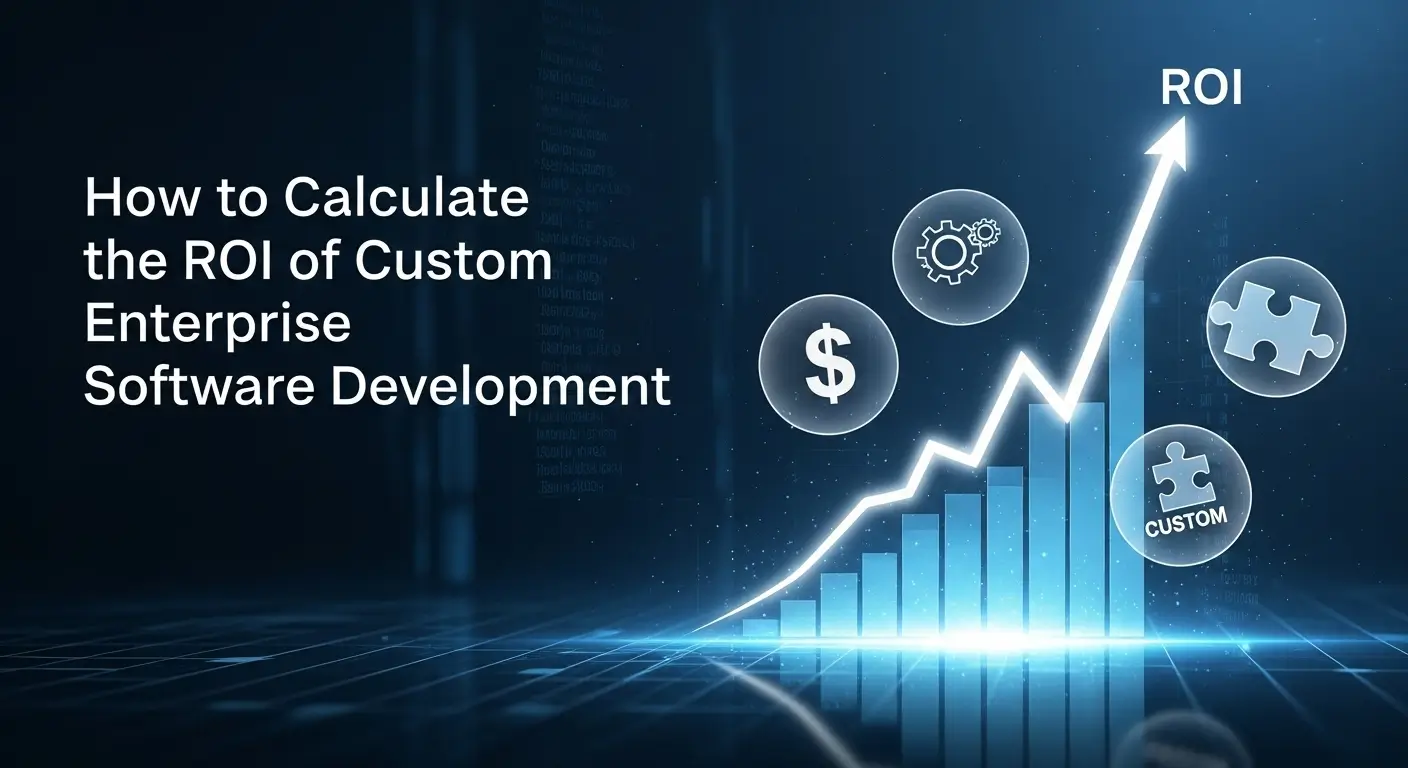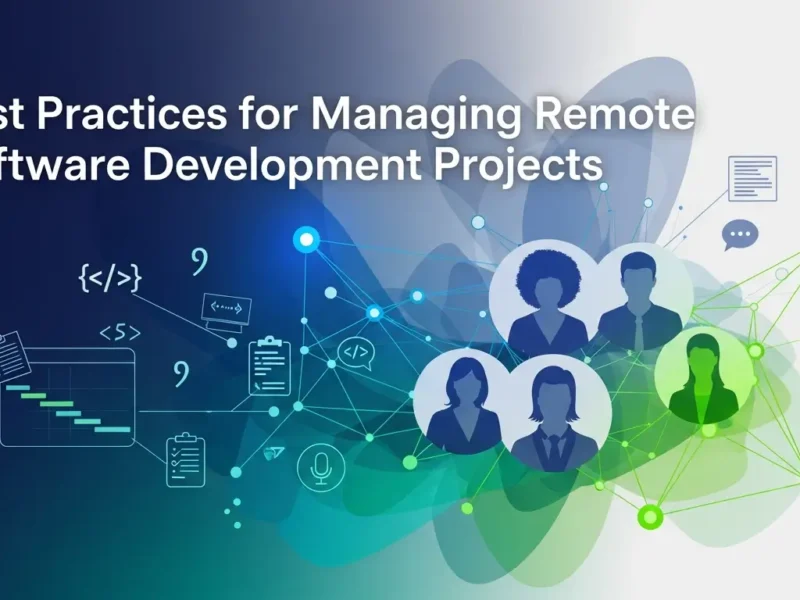Investing in custom enterprise software is a significant strategic decision. It’s not like buying an off-the-shelf product; it’s about commissioning a bespoke tool engineered to solve your unique business challenges, streamline your operations, and create a distinct competitive advantage. But with a price tag that can run into the hundreds of thousands, if not millions, of dollars, the question from every CFO, CEO, and board member is inevitable: “What’s the return on this investment?”
Justifying the expenditure on enterprise software development services requires more than just a gut feeling. It demands a clear, data-driven approach. Calculating the Return on Investment (ROI) for custom software is your financial GPS, guiding your decision-making and proving that the project is not just an expense, but a powerful engine for growth.
This comprehensive guide will walk you through the essential steps to calculate the ROI of custom enterprise software development. We’ll break down the costs, uncover the tangible and intangible benefits, and provide a practical framework to build a compelling business case that resonates with every stakeholder.
Why Calculating ROI for Custom Software is Crucial (and Complex)
Unlike a simple purchase, the ROI of custom software isn’t a straightforward calculation. Off-the-shelf software has a clear price and a defined set of features. Custom software, however, involves a dynamic development process, and its benefits often extend far beyond simple cost savings, touching on productivity, customer satisfaction, and long-term scalability.
A thorough ROI analysis is critical for several reasons:
- Investment Justification:It provides the financial evidence needed to secure budget approval from leadership and investors.
- Prioritization:When faced with multiple potential projects, a comparative ROI analysis helps you allocate resources to the initiatives with the highest potential return.
- Benchmarking Success:It sets clear financial goals for the project, allowing you to measure its actual performance against initial expectations post-launch.
- Informing the “Build vs. Buy” Decision:A clear ROI projection for a custom solution can be directly compared to the Total Cost of Ownership (TCO) and limitations of an off-the-shelf alternative.
The Core Formula: A Starting Point for Your ROI Calculation
At its heart, the ROI formula is simple and universal:
ROI = ( (Gain from Investment – Cost of Investment) / Cost of Investment ) * 100
The result is a percentage that tells you how much value you’re getting back for every dollar you put in. A positive ROI means the investment is profitable; a negative one means it’s a loss.
The real challenge lies in accurately quantifying the two main variables in this equation: the“Cost of Investment”and the“Gain from Investment.”Let’s dive into how to define them for a custom software project.
Step 1: Quantifying the “Cost” – The Total Cost of Ownership (TCO)
The initial development quote is just the tip of the iceberg. To get an accurate picture of your total investment, you need to calculate the Total Cost of Ownership (TCO), which includes all costs associated with the software over its expected lifespan (typically 3-5 years).
Initial Development and Deployment Costs
This is the most visible part of your investment. It encompasses everything required to get the software from an idea to a functioning tool in the hands of your users.
- Discovery & Planning:Workshops, research, requirements gathering, and creating the project roadmap.
- UI/UX Design:Wireframing, prototyping, and creating an intuitive and engaging user interface.
- Software Development:The actual coding and engineering work done by the development team.
- Quality Assurance (QA) & Testing:Rigorous testing to identify and fix bugs before launch.
- Project Management:The cost of overseeing the project to ensure it stays on track and on budget.
- Data Migration:The complex process of moving data from old systems to the new platform.
- Initial User Training:Onboarding sessions and materials to ensure your team can use the new software effectively.
Ongoing and Hidden Costs
These are the recurring expenses required to keep the software running, secure, and effective over time.
- Hosting & Infrastructure:Server costs, whether on-premise or cloud-based (e.g., AWS, Azure).
- Maintenance & Support:Ongoing bug fixes, security patches, and support agreements with your development partner.
- Third-Party Licenses:Costs for any integrated APIs, plugins, or third-party services the software relies on.
- Future Updates & Enhancements:No software is ever “finished.” Budget for future feature additions and improvements based on user feedback and evolving business needs.
By summing up all these initial and ongoing costs over a specific period (e.g., 3 years), you arrive at a comprehensive TCO figure for the “Cost of Investment” in your ROI formula.
Step 2: Quantifying the “Gain” – Uncovering Tangible and Intangible Returns
This is where you identify and assign a monetary value to the benefits the new software will deliver. These benefits fall into two categories: tangible (easy to measure) and intangible (harder to measure, but equally important).
Measuring Tangible Financial Gains
Tangible gains are the direct, measurable financial benefits that your custom software will generate.
- Increased Revenue:
- New Sales Channels:Does the software open up e-commerce capabilities or a new service offering?
- Improved Upselling/Cross-selling:Will it provide your sales team with better data to identify opportunities?
- Faster Time-to-Market:Can you launch new products or services more quickly than competitors?
- Reduced Operational Costs:This is often the most significant source of tangible ROI.
- Business Process Automation:Identify manual, repetitive tasks that the software will automate. Calculate the savings with this simple formula:
(Hours Saved per Employee per Week) x (Number of Employees) x (Average Hourly Employee Cost) x 52 Weeks = Annual Savings - Reduction in Human Error:Calculate the average cost of errors (e.g., incorrect shipments, billing mistakes) and estimate the percentage reduction the software will achieve.
- Lower Infrastructure Costs:Will the new software allow you to retire expensive legacy systems and their associated maintenance contracts?
- Reduced Training Time for New Hires:A more intuitive system can decrease onboarding time and costs.
- Business Process Automation:Identify manual, repetitive tasks that the software will automate. Calculate the savings with this simple formula:
Valuing Intangible Benefits
Intangible benefits are real, but they don’t appear directly on a balance sheet. The key is to find logical ways to estimate their financial impact.
- Enhanced Productivity:While related to automation, this also includes faster access to information and smoother workflows. You can estimate this by surveying teams on time saved in daily tasks.
- Improved Customer Satisfaction and Retention:A better customer portal or faster service can lead to higher satisfaction. You can quantify this by tying it to a projected decrease in customer churn rate. For example, if you reduce churn by 2% and your average customer lifetime value (CLV) is $5,000, you can calculate the added value.
- Better, Faster Decision-Making:Centralized data and real-time analytics dashboards reduce the risk of making costly decisions based on outdated or incomplete information. Quantify this by estimating the cost of one bad decision that could be avoided annually.
- Increased Scalability and Agility:Custom software is built to grow with you. This prevents the massive costs and disruption of having to replace an outgrown off-the-shelf system in the future.
- Enhanced Security and Compliance:A modern, secure system reduces the risk of data breaches, which can cost millions in fines, legal fees, and reputational damage. You can use industry-average costs of a data breach to estimate the value of this risk reduction.
Putting It All Together: A Practical ROI Calculation Example
Let’s imagine a manufacturing company building a custom inventory management system.
The Scenario:They want to replace a cumbersome system of spreadsheets and manual checks that leads to stockouts and overstocking.
Cost of Investment (TCO over 3 years):
- Initial Development & Deployment (based on a quote from a custom software development company): $180,000
- Ongoing Maintenance & Hosting ($1,500/month): $54,000
- Total 3-Year Cost:$234,000
Gain from Investment (Projected over 3 years):
- Reduced Labor (Tangible):Automating manual inventory checks saves 2 employees 15 hours/week each. At an hourly cost of $30, that’s $900/week or $46,800/year.
- 3-Year Gain: $140,400
- Reduced Overstocking Costs (Tangible):Better forecasting reduces excess inventory carrying costs by an estimated $25,000/year.
- 3-Year Gain: $75,000
- Reduced Stockout-Related Lost Sales (Tangible):Fewer stockouts prevent an estimated $30,000 in lost sales per year.
- 3-Year Gain: $90,000
- Improved Order Fulfillment Speed (Intangible -> Tangible):Faster fulfillment leads to a 1% reduction in customer churn, retaining customers worth $20,000 annually.
- 3-Year Gain: $60,000
- Total 3-Year Gain:$140,400 + $75,000 + $90,000 +
60,000=$365,400
Calculating the ROI:
- Net Gain:$365,400 (Gain) – $234,000 (Cost) = $131,400
- ROI:($131,400 / $234,000) * 100 =56.1%
A 3-year ROI of 56.1% is a powerful argument for moving forward with the project.
Your Next Step: From Theory to Action
Calculating the ROI of custom enterprise software is an exercise in diligence and strategic foresight. It transforms a potentially intimidating investment into a clear, justifiable business decision. By meticulously mapping out the Total Cost of Ownership and forecasting both tangible and intangible gains, you create a powerful narrative that proves the project’s value.
Remember, this calculation is not just a hurdle to overcome; it’s the foundation of a successful project, aligning your team, your budget, and your business goals toward a common objective: transformative growth.
Ready to build a powerful business case for your custom software project?The process can be complex, and getting the numbers right is crucial.
Contact our experts for a free consultation. We can help you map out the potential costs, uncover hidden benefits, and calculate a realistic ROI for your unique project, giving you the confidence to make your next strategic move.



